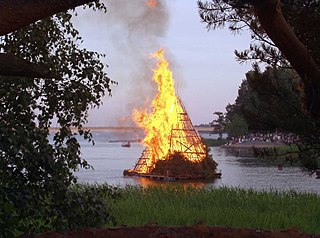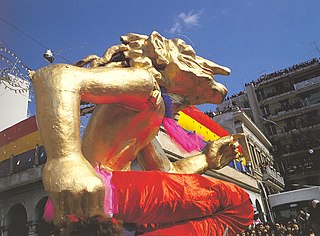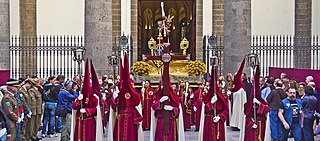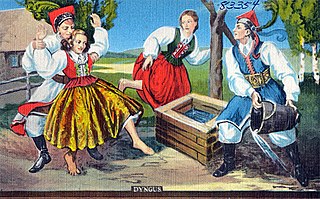
Easter eggs, also called Paschal eggs, are eggs that are decorated for the Christian holiday of Easter, which celebrates the resurrection of Jesus. As such, Easter eggs are commonly used during the season of Eastertide. The oldest tradition, which continues to be used in Central and Eastern Europe, is to dye and paint chicken eggs.

Easter, also called Pascha or Resurrection Sunday, is a Christian festival and cultural holiday commemorating the resurrection of Jesus from the dead, described in the New Testament as having occurred on the third day of his burial following his crucifixion by the Romans at Calvary c. 30 AD. It is the culmination of the Passion of Jesus Christ, preceded by Lent, a 40-day period of fasting, prayer, and penance.

May Day is a European festival of ancient origins marking the beginning of summer, usually celebrated on 1 May, around halfway between the Northern Hemisphere's Spring equinox and June solstice. Festivities may also be held the night before, known as May Eve. Traditions often include gathering wildflowers and green branches, weaving floral garlands, crowning a May Queen, and setting up a Maypole, May Tree or May Bush, around which people dance. Bonfires are also part of the festival in some regions. Regional varieties and related traditions include Walpurgis Night in central and northern Europe, the Gaelic festival Beltane, the Welsh festival Calan Mai, and May devotions to the Blessed Virgin Mary. It has also been associated with the ancient Roman festival Floralia.

Palm Sunday is the Christian moveable feast that falls on the Sunday before Easter. The feast commemorates Christ's triumphal entry into Jerusalem, an event mentioned in each of the four canonical Gospels. Its name originates from the palm branches waved by the crowd to greet and honor Jesus Christ as he entered the city. Palm Sunday marks the first day of Holy Week; in Western Christianity, this is the beginning of the last week of the solemn season of Lent, preceding Eastertide, while in Eastern Christianity, Holy Week commences after the conclusion of Great Lent.

Carnival or Shrovetide is a festive season that occurs at the close of the Christian pre-Lenten period, consisting of Quinquagesima or Shrove Sunday, Shrove Monday, and Shrove Tuesday or Mardi Gras.

Egg decorating is the art or craft of decorating eggs. It has been a popular art form throughout history because of the attractive, smooth, oval shape of the egg, and the ancient associations with eggs as a religious and cultural symbol. Egg decorating has been associated with Easter in recent times, but was practiced independently by many ancient cultures.

A bonfire is a large and controlled outdoor fire, used either for informal disposal of burnable waste material or as part of a celebration.

Holy Week is the most sacred week in the liturgical year in Christianity. For all Christian traditions, it is a moveable observance. In Eastern Christianity, which also calls it Great Week, it is the week following Great Lent and Lazarus Saturday, starting on the evening of Palm Sunday and concluding on the evening of Great Saturday. In Western Christianity, Holy Week is the sixth and last week of Lent, beginning with Palm Sunday and concluding on Holy Saturday.

A quinceañera is a celebration of a girl's 15th birthday that is common in Mexican and other Latin American cultures. The girl celebrating her 15th birthday is a quinceañera. In Latin America, the term quinceañera is reserved solely for the honoree; in English, primarily in the United States, the term is used to refer to the celebrations and honors surrounding the special occasion.

Ukrainian culture is composed of the material and spiritual values of the Ukrainian people that has formed throughout the history of Ukraine. Strong family values and religion, alongside the traditions of Ukrainian embroidery and folk music are integral aspects of the country’s culture. It is closely intertwined with ethnic studies about ethnic Ukrainians and Ukrainian historiography which is focused on the history of Kyiv and the region around it.

Saint George's Day is the feast day of Saint George, celebrated by Christian churches, countries, regions, and cities of which he is the patron saint, including Albania, Bulgaria, England, Ethiopia, Greece, Georgia, Portugal, Romania, Syria, Lebanon, Castile and León, Catalonia, Alcoi, Aragon, Genoa, and Rio de Janeiro.

The Swabian-Alemannic Fastnacht, Fasnacht or Fasnat/Faschnat is the pre-Lenten carnival of Alemannic folklore in Switzerland, southern Germany, Alsace and Vorarlberg.

Maslenitsa, also known as Butter Lady, Butter Week, Crepe week, or Cheesefare Week, is an Eastern Slavic religious and folk holiday which has retained a number of elements of Slavic mythology in its ritual. It is celebrated during the last week before Great Lent; that is, the eighth week before Eastern Orthodox Pascha.

The Patras Carnival, or Patrino karnavali, is the largest event of its kind in Greece. It has more than 180 years of history. The events begin on 17 January and last up to Clean Monday. The carnival of Patras is not a single event but a variety of events that includes balls, parades, hidden treasure hunt and the children's carnival amongst others. It climaxes in the last weekend of Carnival with the Saturday evening parade of carnival groups, the extravagant Sunday parade of floats and groups, and finally the ritual burning of the carnival king at the St. Nikolaos Street pier in the harbour of Patras. Its characteristics are spontaneity, improvisation, inspiration and volunteerism. In 2019, there were about 750.000 participants in the carnival

Holy Week in Spain is the annual tribute of the Passion of Jesus Christ celebrated by Catholic religious brotherhoods and fraternities that perform penance processions on the streets of almost every Spanish city and town during the Holy Week –the last week of Lent, immediately before Easter–.

Easter traditions are customs and practices that are followed in various cultures and communities around the world to celebrate Easter, which is the central feast in Christianity, commemorating the resurrection of Jesus. The Easter season is seen as a time of celebration and feasting, in contrast to the antecedent season of Lent, which is a time of penitence and fasting.

Śmigus-dyngus or lany poniedziałek is a celebration held on Easter Monday across Central Europe, and in small parts of Eastern and Southern Europe. The tradition is widely associated with Poland in English-speaking countries and is observed by Polish diaspora communities, particularly among Polish Americans who call it Dyngus Day. The tradition is also deeply rooted in Hungary.

Holy Week in Mexico is an important religious observance as well as important vacation period. It is preceded by several observances such as Lent and Carnival, as well as an observance of a day dedicated to the Virgin of the Sorrows, as well as a Mass marking the abandonment of Jesus by the disciples. Holy Week proper begins on Palm Sunday, with the palms used on this day often woven into intricate designs. In many places processions, Masses and other observances can happen all week, but are most common on , Good Friday, Holy Saturday and Easter Sunday, with just about every community marking the crucifixion of Jesus in some way on Good Friday. Holy Saturday is marked by the Burning of Judas, especially in the center and south of the country, with Easter Sunday usually marked by a Mass as well as the ringing of church bells. Mexico's Holy Week traditions are mostly based on those from Spain, brought over with the Spanish conquest of the Aztec Empire, but observances have developed variations in different parts of the country due to the evangelization process in the colonial period and indigenous influences. Several locations have notable observances related to Holy Week including Iztapalapa in Mexico City, Taxco, San Miguel de Allende and San Luis Potosí.

The holiday of Easter is associated with various Easter customs and foodways. Preparing, coloring, and decorating Easter eggs is one such popular tradition. Lamb is eaten in many countries, mirroring the Jewish Passover meal.

Slavic carnivals are known under different names in various Slavic countries: Bulgarian: Сирни заговезни, Прошка, Поклади, romanized: Sirni zagovezni, Proshka, Pokladi; Macedonian: Прочка, romanized: Pročka; Russian: Масленица, Мясопуст, romanized: Maslenitsa, Myasopust; Polish: Ostatki, Mięsopust, Zapusty; Czech: Masopust, Šibřinky, Ostatky; Slovak: Fašiangy; Slovene: Mesopȗst, Pust, Pustni teden, Fašnk; Serbian: Покладе, Проћка / Poklade, Proćka; Croatian: Pust, Poklade, Mesopust, Fašnik. They are traditional Slavic festivals related to the period of carnival.



















